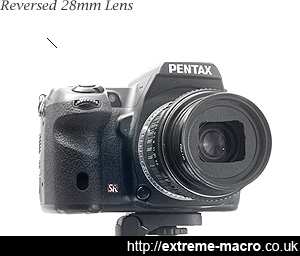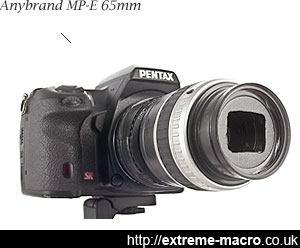Extreme Macro Lenses
by Johan J Ingles-Le Nobel
Last updated August 31, 2017
The first question that anyone asks about extreme macro photography is just about always "which lens should I buy?"
A reversed 28mm lens, a budget way to start macro photography without a macro lens. In terms of starting out though, macro closeup adapters are a much more rewarding way to learn.
This is difficult to answer in just a few sentences as extreme macro lenses are a different proposition to the standard 'off the shelf' consumer lenses.
Not only are there very different considerations with extreme macro lenses with respect to macro lenses, but there are also different makes and marketplaces involved. Many are old, or custom, and rather than buying one off the shelf, there's a bit of speculation involved.
Extreme Macro Lenses
The extreme macro photography lens landscape is one that is largely unmapped and undefined. In extreme macro there is in fact only one easily sourced lens from any camera make that has any value, the fabulous Canon Mp-e 65. If you want to specialise in just extreme macro, Canon is undoubtedly the brand to buy into.
The cheapest way to start extreme macro is to reverse an old manual lensThe Canon Mp-e 65 is a superb lens that will go from 1:1 to 5:1 but there is a cheaper alternative. Other than this lens, the specialist lenses we use in extreme macro range from reversed enlarger lenses through to microfilm lenses, with microscope objectives in use as well.
Although there are a few well know performers, beyond that extreme macro lenses are largely a matter of experience through trial and error, and likely good lenses based on their optical construction. The great lenses used in extreme macro include the easy to source enlarging lenses like the el-nikkor 50mm, the Componon 28, Componon 35 and Componon 80, and if you're after more high magnification, a Nikon 10x or Reichert 10x objective might fit the bill. Read more about extreme macro lenses. Microfilm lenses can give outstanding high magnification images as well. Lastly, there's the absolutely epic JML 21mm, but this really is now unbelievably difficult to find.
Reversing Lenses For Extreme Macro
There are also various ways to get into extreme macro photography without incurring the expense of specialised lenses such as those referred to above: for example reversed single lenses and reversed lenses on other lenses. The cheapest way to start extreme macro is to reverse an old manual lens. This can create spectacularly good photographs. Cheapest isn't necessarily best though, and for the smoothest learning curve, consider using learning with some Raynox adapters first. Learning how to use reversed lenses becomes much easier after using Raynoxes.
Macro Lenses
The lenses for macro photography are usually off the shelf branded lenses, and can vary in price from £25 (used, eBay) to a four or five figure sum for a top notch fast aperture specially-coated lens from a named manufacturer.
The anybrand Mp-e 65mm extreme macro lens - how to make your own Mp-e 65mm for any brand of camera.
There are various things you should look for when you purchase or consider a lens for conventional macro photography. You want the right focal length for your subject, a nice long and sensitive focus throw, better resolution in the macro areas of the scale, a fast lens for a beautiful blurry background bokeh, a focus limiter is always nice, a deeply recessed hood (to avoid flare), solid construction, and above all, great optics. Believe it or not autofocus is actually usually a waste of time for macro: read more about manual macro lenses of choice here.
Closeup Lenses
Closeup lenses (diopters that are added in front of lenses) provide a fantastic entry point into extreme macro photography. There are both advantages and disadvantages using these; but be warned, those cheap eBay closeup lenses are a thing of the devil and should be avoided for anything other than dipping a toe in the water. On the other hand, quality closeup lenses provide a superb way into extreme macro as you preserve in-camera metering and autofocus. There are some real bargains out there to consider - see here to read more about quality closeup diopters and what makes some better than others.
Extreme Macro Lens Buying
Extreme macro lenses are a subject of considerable lens 'fetish'. It is all to easy to buy a lens only to buy another shortly afterwards because it is supposed to be 'better'.
It is not the quality of the lens that limits most people's macrosExcessive lens purchasing should be avoided; once you have a certain level of lens it is much more sensible to improve on photography lighting and technique for image quality improvement rather than expensive new lens purchases. It is easy to buy unnecessary lenses. Buying a terrible macro lens is actually quite a tricky feat to achieve but terrible macro photography is not. It is not the quality of the lens that limits most people's macros; it is usually lack of knowledge of the whole package. The difference between a £50 Componon and a £500 Componon-S is, in truth, marginal, and barely noticeable in anything but the most minute examination of final images.
Related Articles







